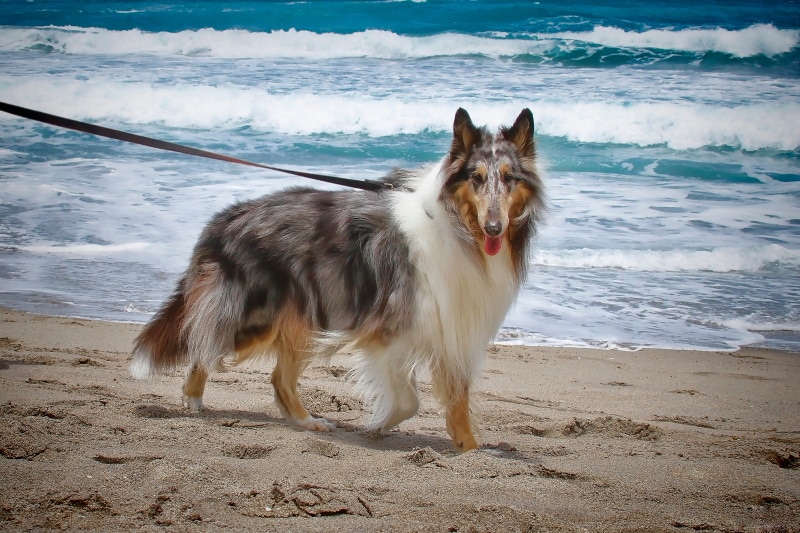Do Shetland Sheepdogs (Shelties) Like Water? Breed Facts & FAQ

Updated on

If you’re a proud owner of a Sheltie, you know how much joy and companionship they bring to your life. These intelligent and affectionate dogs love to explore and play, but have you ever considered taking your furry friend for a swim? Generally speaking, these pups don’t like water but you can train them to swim.
While some Shelties might be hesitant to dip their paws in the water, with the right approach, you can make a splash with your pup and introduce them to the joys of swimming. Choosing the right location and using positive reinforcement are a couple of ways to help you create a fun and safe environment for your pup to make a splash.
Do Shelties Like Water?
While Shelties can be trained to swim and will have the potential to become awesome swimmers, these dogs aren’t really natural water lovers, unlike breeds such as Retrievers and English Setters. These dogs were bred for herding, so swimming wasn’t a priority for them over the past centuries. You may find that they’re rather cautious around water and may take a bit to get comfortable in the water. But with careful monitoring and instruction, you can help your Sheltie become a water baby in no time.
Shetland Sheepdogs Temperament

Before introducing your dog to water, it’s important to understand this breed’s normal temperament. Some Shelties may have a natural aversion to water, while others may be curious and willing to explore. It’s essential to assess your Sheltie’s personality and behavior to determine if they’re ready for a swim.
If your Sheltie is generally cautious or fearful of new experiences, it’s crucial to introduce them to water gradually. So start with small amounts of water in a controlled environment, such as a bathtub, and use positive reinforcement (verbal and/or treats) to help them feel comfortable. If your Sheltie has a more adventurous personality, you can introduce them to water in a more open setting, such as a pond or lake.
Regardless of your Sheltie’s temperament, patience and consistency are key to making the introduction to water a success. With time and practice, your furry friend can learn to love the water and enjoy swimming.
Why Swimming Can Benefit Your Sheltie
Swimming has numerous benefits for Shelties, both physically and mentally. As a low-impact exercise, swimming can help improve your Sheltie’s cardiovascular health and muscle tone. It’s an excellent way for your furry friend to burn off excess energy and stay active, which can reduce the risk of obesity and related health issues.
Swimming can also be a great way to improve your Sheltie’s mental health. The calming effect of the water can reduce stress and anxiety, and the socialization opportunities can help build confidence and strengthen the bond between you and your furry friend.
Overall, swimming is a fun and healthy activity that can provide numerous benefits for your Sheltie. With proper training and precautions, your furry friend can enjoy the water for years to come.
Preparing for the First Swim

Before heading to the water, it’s crucial to prepare both yourself and your furry friend. Make sure you have all the necessary equipment, such as a leash, water toys, and a life jacket for your Sheltie. It’s also essential to check the weather and water conditions to ensure it’s safe for swimming.
When preparing your dog for their first swim, start by introducing them to the water gradually. Take them to a shallow area and let them explore the water without pressure. Use positive reinforcement, such as treats and praise, to help them associate the water with positive experiences.
It’s also crucial to practice basic commands, such as “Come” and “Stay,” to ensure your dog’s safety in the water. With patience and practice, your pup will be ready to dive in and enjoy the water.
Introducing Your Sheltie to Shallow Water
When introducing your dog to water, always start with shallow areas. Find a calm and shallow spot or start right in your bathtub or an outdoor kiddie pool, and let your dog explore at their own pace. Use positive reinforcement to help them associate the water with positive experiences.
Always monitor your Sheltie’s behavior and body language to ensure they’re comfortable and safe. If they show signs of distress, such as excessive panting or shaking, it’s likely time to take a break and try again later.
As your pup becomes more comfortable in shallow water, gradually increases the depth and distance from shore. Make sure to always supervise your furry friend and use a life jacket for added safety.
Teaching Your Sheltie to Swim

Teaching your Sheltie to swim requires patience, practice, and positive reinforcement. Start by holding your Sheltie in the water and encouraging them to paddle their feet. Use treats and praise to make the experience positive and enjoyable.
As your Sheltie becomes more comfortable, gradually release your grip and let them swim on their own. Use toys and treats as a reward for swimming and coming back to you. Avoid forcing your Sheltie to swim or throwing them into deep water, as this can cause fear and distress. Instead, take it slow and let your furry friend learn at their own pace.
After a swim, you may notice that your dog’s coat is looking a bit lackluster and not as shiny as usual. This is because chlorine, saltwater, and other chemicals found in pools and natural bodies of water can damage your dog’s coat and cause it to become dry and brittle.
But don’t worry; with the right care and attention, you can keep your dog’s coat healthy and shiny even after a swim.
Understanding the Effects of Chlorine and Saltwater on Dog Coats
Chlorine and saltwater can have a harsh impact on your dog’s coat. Chlorine is a chemical commonly found in swimming pools, and it’s used to kill bacteria and other harmful microorganisms that may be present in the water.
While chlorine is essential for keeping the pool clean and safe, it can also strip your dog’s coat of its natural oils, leaving it dry and brittle. Saltwater, on the other hand, can have a similar effect on your dog’s coat. The high salt content in seawater can cause your dog’s coat to become dehydrated, leading to breakage and split ends.
Also note that chlorine and saltwater can cause skin irritation and other health problems for your dog. If your dog is constantly exposed to these chemicals, it can lead to dry, itchy skin, hot spots, and even infections. That’s why it’s essential to take the necessary steps to protect your dog’s coat and skin before and after a swim.
Tips for Pre-Swim Coat Care

Before you take your Sheltie for a swim, it’s important to prepare their coat for the water. Here are a few tips for pre-swim coat care.
Brush your Sheltie’s coat thoroughly. This will help remove any tangles or mats that may be present in the coat. Tangles and mats can trap water and chemicals, making it harder to rinse them out later.
Next, apply a coat conditioner. A good coat conditioner can help protect your dog’s coat and prevent damage caused by chlorine and saltwater. Look for a conditioner that’s specifically designed for dogs and safe for use in swimming pools or natural bodies of water.
Lastly, apply dog sunscreen if you’re on the beach or out in the backyard. Believe it or not, just like humans, dogs can get sunburned. If you’re planning to spend a lot of time in the sun, consider applying dog-specific sunscreen to your dog’s coat and skin.
Tips Post Swim Care
After a swim, always rinse your dog if they’ve been in a pool with chlorine or in a lake or ocean (especially oceans, to rinse off the salt). Next, be sure to dry your dog’s coat thoroughly. Leaving your dog’s coat wet can lead to skin irritation and other health problems. To do this, you can use a towel or blow dryer to remove any excess water.
Conclusion
Swimming can be a fun and healthy activity for you and your Sheltie. With patience, practice, and positive reinforcement, you can introduce your furry friend to the joys of swimming and create lasting memories in the water. Remember to always prioritize safety and monitor your Sheltie’s behavior and energy levels. With these tips, your furry friend will be ready to make a splash and enjoy the water!
Featured Image Credit: K E Walker, Shutterstock












